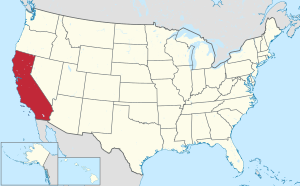Trinity County, California
Trinity County | |
|---|---|
 Location within the U.S. state of California | |
 California's location within the U.S. | |
| Coordinates: 40°40′N 123°07′W / 40.66°N 123.12°W | |
| Country | |
| State | |
| Founded | 1850 |
| Seat | Weaverville |
| Population (2000) | |
| • Total | 13,022 |
| Website | www |
Trinity County is a large, rugged and mountainous, heavily forested county located in the northwestern portion of the U.S. state of California, along the Trinity River and within the Salmon/Klamath Mountains. As of 2000 its population was 13,022. Its county seat and largest town is Weaverville, at around 3500 people. There are no incorporated cities in Trinity County, and there is not a single traffic light.
History
Trinity County was one of the original counties of California, created in 1850 at the time of statehood. Parts of the county were given to Klamath County in 1852 and to Humboldt County in 1853. Klamath County ceased to exist in 1876 after it was dissolved due to corruption and wide spread electoral fraud.
The county takes its name from the Trinity River, named in 1845 by Major Pearson B. Reading, who was under the mistaken impression that the river emptied into Trinidad Bay. Trinity is the English version of Trinidad.
Geography
According to the U.S. Census Bureau, the county has a total area of 8,307 km² (3,208 mi²). 8,233 km² (3,179 mi²) of it is land and 75 km² (29 mi²) of it (0.90%) is water. The county contains a singificant portion of Shasta-Trinity National Forest, home to the Trinity Alps. The county hosts many visitors, especially during summer months, for camping, backpacking, and fishing.
Cities and towns
Adjacent Counties
- Mendocino County, California - south
- Humboldt County, California - west
- Siskiyou County, California - north
- Shasta County, California - east
- Tehama County, California - southeast
Transportation Infrastructure
Major Highways
Demographics
As of the census2 of 2000, there were 13,022 people, 5,587 households, and 3,625 families residing in the county. The population density was 2/km² (4/mi²). There were 7,980 housing units at an average density of 1/km² (2/mi²). The racial makeup of the county was 88.87% White, 0.45% Black or African American, 4.85% Native American, 0.47% Asian, 0.12% Pacific Islander, 0.88% from other races, and 4.38% from two or more races. 3.97% of the population were Hispanic or Latino of any race.
There were 5,587 households out of which 25.40% had children under the age of 18 living with them, 50.50% were married couples living together, 10.10% had a female householder with no husband present, and 35.10% were non-families. 29.50% of all households were made up of individuals and 11.10% had someone living alone who was 65 years of age or older. The average household size was 2.29 and the average family size was 2.80.
In the county the population was spread out with 22.80% under the age of 18, 5.10% from 18 to 24, 22.70% from 25 to 44, 32.10% from 45 to 64, and 17.20% who were 65 years of age or older. The median age was 45 years. For every 100 females there were 104.20 males. For every 100 females age 18 and over, there were 102.60 males.
The median income for a household in the county was $27,711, and the median income for a family was $34,343. Males had a median income of $31,131 versus $24,271 for females. The per capita income for the county was $16,868. About 14.10% of families and 18.70% of the population were below the poverty line, including 26.20% of those under age 18 and 7.20% of those age 65 or over.

